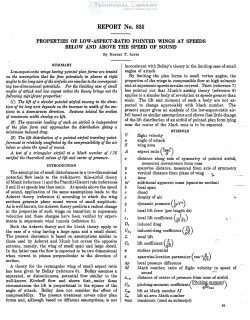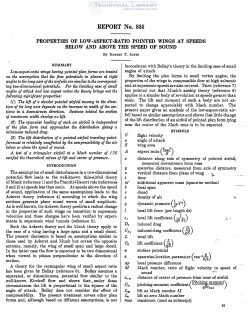naca-report-835

- Version
- 245 Downloads
- 560.33 KB File Size
- 1 File Count
- August 31, 2016 Create Date
- August 31, 2016 Last Updated
National Advisory Committee for Aeronautics, Report - Properties of Low Aspect Ratio Pointed Wings at Speeds Below and Above the Speed of Sound

The assumption of small disturbances in a two-dimensional
potential flow leads to the well-known thin-airfoil theory
of Munk (reference 1) and the Prandtl—Glauert rule (references
2 and 3) at speeds less than sonic. At speeds above the speed
of sound, application of the same assumptions leads to the
Ackeret theory (reference 4) according to which the wing
sections generate plane sound waves of small amplitude.
As is well known, the Ackeret theory predicts a radical change
in the properties of such wings on transition to supersonic
velocities and these changes have been verified by experi-
ments in supersonic wind tunnels (reference 5).
Both the Ackeret theory and the Munk theory apply to
the case of a wing having a large span and a small chord.
The present discussion is based on assumptions similar to
those used by Ackeret and Munk but covers the opposite
extreme, namely, the wing of small span and large chord.
In the latter case the flow is expected to be two dimensional
when viewed in planes perpendicular to the direction of
motion.
A theory for the rectangular wing of small aspect ratio
has been given by Bollay (reference 6). Bollay assumes a
separated, or discontinuous, potential flow similar to the
well—known Kirchofi‘ flow and shows that ,under these
circumstances the lift is proportional to the square of the
angle of attack. Bollay does not consider the' effect of
compressibility. The present treatment covers other plan
forms and, although based on different assumptions, is not
inconsistent with Bollay’s theory in the limiting case of small
angles of attack.
By limiting the plan forms to small vertex angles, the
properties of the wings in compressible flow at high subsonic
and at supersonic speeds are also covered. Tsien (reference 7)
has pointed out that Munk’s airship theory (reference 8)
applies to a slender body of revolution at speeds greater than
sonic. The lift and moment of such a body are not ex-
pected to change appreciably with Mach number. The
present paper gives an analysis of the low-aspect-ratio air-
foil based on similar assumptions and shows that little change
of the lift distribution of an airfoil of pointed plan form lying
near the center of the Mach cone is to be expected.
| File | Action |
|---|---|
| naca-report-835 Properties of Low Aspect Ratio Pointed Wings at Speeds Below and Above the Speed of Sound.pdf | Download |
Comment On This Post